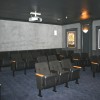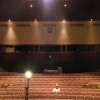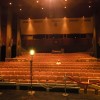Fixed Audience Seating
Video
alt="" Home Theater SeatingFixed audience seating refers to the raised indoor chairs that we use in theaters, auditoriums, lecture halls and churches. Their most basic function is to provide a location for individuals to be seated at a venue or facility where many people are present. Fixed audience seating is commonly organized in rows on flat or pitched floors with level terraces. The seating layout should allow an audience to clearly see and hear a speaker, show or performance. Depending on the use or application, in both new and existing facilities, fixed audience seating may be of a basic design, meeting the minimal functional requirements of a space, or they may be of a fashionable design, not only meeting the functional requirements of a space but also enhancing the architectural motif by employing aesthetically pleasing fabrics, finishes and details.
Fixed audience seating is intended to provide desired comfort characteristics based on the median of those in attendance. Audience members may be very different as individuals with respect to size, age and expectations, yet, by its nature, audience seating must be uniform in size and position. Chair dimensions, therefore, come in a range of sizes, and must be selected for a given application based upon considerations such as the intended audience, the quality of the space, and the nature of the venue. Dimensions in both seat and seat back have variations in width, depth, height and inclination. In addition, a seat may have arm rests at a specific height, or have no arm rests at all.
The materials, as well as the dimensions, contribute to the desired comfort level. Seating may be hard, molded plastic or have cushioned, fabric-covered surfaces. Cushioning materials, including open-cell and molded foam, can be shaped or contoured. The texture of the fabric plays a role in a seat's comfort. Fabric is usually made from synthetic textiles, but may include plant textiles as well. Fabrics may be an olefin/polyester blend, cotton/polyester blend, PVC free polyurethane, nylon, polyester, vinyl or a blend of post consumer/post industrial recycled polyester.
While considering the comfort factor of fabric and cushions, an owner should also consider his facility's traffic and the material's durability. Audience seating that is in constant use will experience significant wear from abrasion. Fabric has both an abrasion resistance rating and a flammability rating, which assist in selecting a proper fabric for a specific volume of use and code required flame resistance. Similarly, cushioning will compress over time. Higher quality foam will prevent this from occurring too early due to high traffic and usage.
Fixed audience seating has a variety of other components which also affect its use and appearance. Seating may be attached to the floor with feet, as is the case in most movie theaters, or it can be fastened to a rail and supported by pedestals that are attached to the floor, similar to those in a lecture hall. Depending on the construction, the manufacturer, and the seat's intended use, a great deal of options are available. Seat pans can be steel, fully upholstered, plastic or wood. Standards may be cast iron or steel, and end panels can be metal, wood or plastic. The variety of fabric colors and patterns, wood finishes, and metal finishes, in addition to the availability of high pressure laminates, serve to enhance the appearance of audience seating. Additional options may include raised arms, gravity self-riding seats, holders, tablet arms, power and data service, integral lighting, numbering and lettering.
With so many options, it is recommended that prior to selecting fixed audience seating, the specific needs for the space, budgets and maintenance be considered. This will help to differentiate the various options related to seating in a specific project. Fixed audience seating and layout is required meet building code requirements and design standards, such as ADA Standards for Accessible Design and ADA Accessibility Guidelines for Buildings and Facilities.

Buildipedia Staff
The Buildipedia research and writing staff consists of dozens of experienced professionals from many sectors of the industry, including architects, designers, contractors, and engineers.
Website: buildipedia.com/


